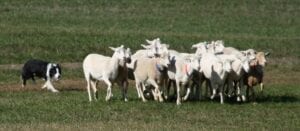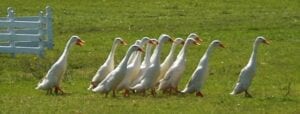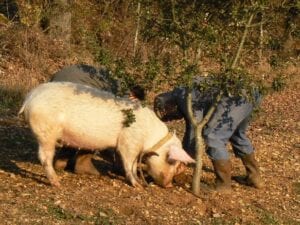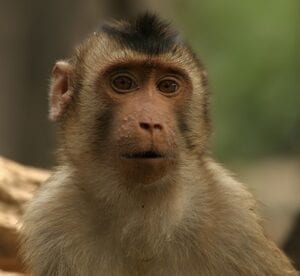Day 20: Working Animals Part I—Small Animals (Canines, Felines, Fowl, And Swine)
Dear Student,
Animals are an essential part of most farm operations, whether they’re providing food, materials (wool, feathers, etc.), or being used as a helper. Today, to begin our 11-class chapter on animals, I’d like to introduce you to the world of working animals…
Correctly trained working animals are both amazing to watch and worth their weight in gold on many on farm operations, saving humans much time and effort.
Traditionally, many animals were trained to do farm jobs that have been made obsolete by machinery or chemicals… yet others have disappeared and not been replaced with anything modern.
Today, I’ll introduce you to some of the smaller helpers you might want to employ on your homestead, and tomorrow I’ll discuss some of the larger options.
What Is A Working Animal?
When we talk about working animals, we don’t count animals that are simply producing food on the farm, making eggs or milk, for example. A working animal fulfills a function that would require extra labor on your behalf to achieve.
Today I’m offering a list of working animals and the task they can perform for you. Some have to be trained to perform these functions and some do them naturally, but some or many of them could be of benefit to you if you take a little time to train or put the necessary systems in place.
Canines
 It takes months of patient instruction to train a working dog and sometimes years to get a dog to peak working performance.
It takes months of patient instruction to train a working dog and sometimes years to get a dog to peak working performance.
One of the biggest issues many people have with working dogs is not being able to let go of the idea that they are pets. Working dogs are not pets and should not be treated as family members. If you do so, you will undo the very special, painstaking training that you’ve spent so long (or paid) to achieve. If a working dog is petted or rewarded for actions that are not directly related to a work task completed, it will confuse the dog, making it harder to understand and follow the instructions you give it next time.
A working dog is like an employee, you treat it well and reward its good performance and obedience. These are not dogs to cuddle, if you want a snuggling companion, then you need to get a house dog.
You can purchase a great working dog with all its basic training for a small fee.
If you are lucky enough to have a guide dog school near you, you might be able to adopt a guide dog that failed its final training evaluation. These dogs can be highly trained, but one weakness (afraid of plastic bags or tendency to chase cars) will make it useless as a guide dog.
Sheep and Herding Dogs: A well-trained sheep or herding dog can make livestock management infinitely easier. These dogs can be trained to manage and move an entire herd of sheep or cattle on their own and can follow highly complicated commands. They can even be trained to identify and remove a single, specific sheep from the herd.
Having to chase escaped or uncooperative animals yourself is at best a huge waste of time and unsafe or beyond many people’s abilities at worst. Have a dog do all this for you. A lot of effort can go into fully training a working dog, but the rewards are well worth it.
Security Dogs: Most dogs offer some security and many large breeds make for great deterrents to intruders and predators on your homestead just by their presence alone. A properly trained security dog can be a most formidable form of security from predators, both two-legged and four-legged, both at home and when you are working in remote areas.
Livestock Guardian Dogs (LGDs): These can be trained to protect herds of animals if there are natural predators in the area. Anatolians, for example, are used in Africa to protect herds of goats against large predators. To become an LGD, puppies of specific breeds are introduced to the herd or flock when still very young (6 weeks old), so the herd is imprinted on them as their pack.
Sled Dogs: In cold climates, dogs like huskies are used for traction and transportation.
Rescue and Tracking Dogs: To this day, dogs are used to find good people trapped in avalanches and collapsed buildings… along with bad people on the run!
Hunting Dogs: Invaluable for tracking animals and retrieving small game for the hunter.
Guide Dogs and Companion Dogs: Nowadays most are familiar with this form of working animal, providing emotional support and freedom to people who need them.
Felines
Cats: Have always been kept on farms (and in businesses and on ships) as mousers and ratters. To ensure peak performance, they were kept semi-feral, with only moderate feeding and good housing provided, after that they are expected to earn their keep removing rodents and small pests—don’t try make a house pet out of your working cat. No training necessary.
Fowl
When it comes to fowl, the majority of common uses are based on natural behaviors, so no training is needed to put these working animals to the job. (If you want to train carrier or homing pigeons, that’s a different story.)
 Geese: Will eat weeds out of your pasture and garden and are great watch birds., creating an unholy racket if intruders or predators come onto your property. No training necessary.
Geese: Will eat weeds out of your pasture and garden and are great watch birds., creating an unholy racket if intruders or predators come onto your property. No training necessary.
Ducks: Will pick your garden and orchard clean of pests. As the late Bill Mollison put it, “You don’t have a slug problem, you have a duck deficiency.” Vergenoegd Wine Estate in South Africa allows 800 Indian runner ducks into the vineyard daily. They race eagerly to “work” every morning, and they’ve allowed the vineyard to remove chemical pesticides from their operation. The ducks fertilize the grapes and lay vast quantities of eggs too. No training necessary.
Guinea Fowl: Will reduce ticks, kill small snakes, and need very little care. They are tasty, too! No training necessary.
Pigeons: Used to transport messages and small packages, and continue today as racing birds for sport. Some rearing practices needed.
Swine
Pigs are incredibly intelligent—they are smarter than dogs—and are highly trainable. With some patience and training, you could feasibly train a pig to do a laundry list of chores for you.
Plus, they are nature’s great recyclers, eating just about anything and turning it into primo fertilizer.
 Pigs naturally root and till up soil, which in itself is a useful little trick. If you have root-filled, compacted, or scrubby soil, you can confine pigs on a small area at a time with good supplemental feeding and their natural instinct is to till and eat roots and pests. They essentially plow and prep your land for you when needed, leaving you with tilled, heavily fertilized soil that’s suitable for final preparation before planting.
Pigs naturally root and till up soil, which in itself is a useful little trick. If you have root-filled, compacted, or scrubby soil, you can confine pigs on a small area at a time with good supplemental feeding and their natural instinct is to till and eat roots and pests. They essentially plow and prep your land for you when needed, leaving you with tilled, heavily fertilized soil that’s suitable for final preparation before planting.
Truffles are one of the most expensive foods in the world, with some specimens selling for thousands and tens of thousands of dollars, and pigs are trained to hunt for truffles in parts of the United States, Europe, and Russia.
If you are interested in rearing pigs and truffles do well in your area, it could be fun to put your pig on a leash and take him truffle hunting after a little training. (The leash is because the pig is more likely to eat the truffle than hand it over… you can give him another less-expensive treat as a reward).
Others
Rats have been used to find landmines…
Dolphins have been used to attach mines and explosives to ships and submarines…
I don’t see these as particularly useful homestead skills, but it goes to show you the vast potential some animals have to be trained for specific tasks.
Manatees are used to clear canals and waterways of grass and weeds in South America—this might actually have some use to you if you have some water sources you’d like cleared… but obtaining a manatee for the job isn’t too likely.
Crows have a natural propensity for collecting things (for nesting) and are incredibly smart. One man trained them to use a vending machine in his backyard, inserting coins (that he made available to them) for grain. The concept is being put to large-scale public use by having crows collect cigarette butts (which they already do naturally) to exchange them for food—instead of having the carcinogens end up in their nests.
Crows can even teach each other skills. The man with the vending machine started with one crow, who brought another and taught him the trick. Within days the man had a yard full of crows, and whenever he left the house they’d flock en masse, knowing he was refilling the machine with new food.
If you’ve got an aviary interest, you could certainly invest some time in training your local crow population to collect small items (or pests) for you.
 Monkeys can be trained to pick coconuts (and pockets). In Thailand, pigtailed macaques are trained to pick coconuts, with males picking up to 1,600 ripe coconuts per day while humans can pick only about 80.
Monkeys can be trained to pick coconuts (and pockets). In Thailand, pigtailed macaques are trained to pick coconuts, with males picking up to 1,600 ripe coconuts per day while humans can pick only about 80.
“It would be difficult to find a coconut product made in Thailand that wasn’t picked by a monkey,” comments monkey trainer Arjen Schroevers, who practices a Buddhist form of humane monkey training.
Again, you’re probably not likely to go and buy a monkey to train to pick your fruits for you, but I wanted to illustrate just how creatively animals can be put to use for humans. Think outside the box.
Stay tuned tomorrow for more about the larger working animals your farm might benefit from…
